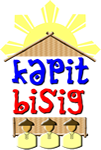Festivals - Page 2 of 2
14 May - Carabao Festival
The Carabao – the water buffalo – the farmer’s best friend, is groomed, decorated and paraded around the town of Pulilan, Bulacan. The highlight is seeing the carabao kneel before the church and compete in races.
15 May - Pahiyas
In thanksgiving to San Isidro for the bountiful harvest, the patron saint of farmers, the towns of Lucban and Sariaya in Quezon City happily celebrate his feast day with processions. The façade of houses are creatively decorated with agricultural products and "kiping", a wafer-thin bunting made rice paste dyed in warm colors and hung in various shapes and sizes.
17 to 19 May - Sayaw sa Obando
During these three days, a series of dance processions are offered in Obando, Bulacan. On May 17, young unmarried men dance in the street while praying to find a bride. The next day is the turn of single young women. Finally, on the last day childless couples perform a fertility dance in their desire to have children.
24 June - Feast of San Juan Bautista
A wet and wild feast day in remembrance of St. John the Baptist held in San Juan, Metro Manila. Water is thrown at passing cars and everyone else. Be prepared to get wet. In Balayan, Batangas, it is "dry" but mouthwatering celebration. Instead of throwing water, the parade of lechon (roasted pigs) highlight this day.
29 June - Pintados
This "painted festival" in Tacloban on Leyte celebrates the traditional tattoing practiced before the Spanish arrived (though nowadays water-based paints are used for the festival’s body decoration).
Second week of August - Kadayawan
The chief Festival of Davao City honoring Mt. Apo, durian fruits, and waling-waling orchids. The festival is a celebration of life, a thanksgiving for the gifts of nature, the wealth of culture, the bounties of harvest and serenity of living. Davao showcases its Muslim, Chinese and tribal influences with costumed street parades, dances and performances, along with fantastic displays of fruits and flowers.
Third week of September - Peñafrancia Festival
An impressive river parade in Naga City honoring the Blessed Virgin Mary, thousands of devotees make a pilgrimage to Naga in Southeast Luzon for the celebration of the Virgin of Peñafrancia, the Bicol region’s patron saint.
1 to 12 October - Zamboanga La Hermosa Festival (popularly known as Fiesta Pilar)
Cultural performances, religious ceremonies, exhibitions, regattas, street parades, fireworks displays, beauty contests and a regatta which sees numerous boats with brightly-colored sails are held in Zamboanga for its patron saint, Nuestra Señora del Pilar. The people of Zamboanga intensely believe that the lady has served as their unifying cultural and historical symbol.
19 October (or on the weekend closest to October 19th) - Maskara
The biggest festival in the Negros Province happens in Bacolod city (as the "City of Smiles"). Street dancers wear costumes and elaborate smiling masks and dance to Latin rhythms of Rio de Janiero style.
22 to 23 November - Higantes
Feast of Angono, Rizal in honor of patron St. Clemente. Higantes ("giants") are huge paper-mache figures (measuring the four to five feet in diameter and ten to twelve feet in height) dressed in native costumes.
15 to 19 December - Shariff Kabunsuan Festival
This event in Cotabato City in Mindanao commemorates the arrival of Islam in the region and involves river parades of decorated boats.
December (Saturday before Christmas Eve) - Giant Lantern Festival
The most spectacular lantern parade and contest in the Philippines takes place in San Fernando, Pampanga. The giant "parols" (colored paper lanterns) measuring over ten feet in diameter come to life in a spectacular synchronized show of lights and sounds. With the popularity of the festival, the city has been called the "Christmas Capital of the Philippines". The giant lanterns remain on display until January.
